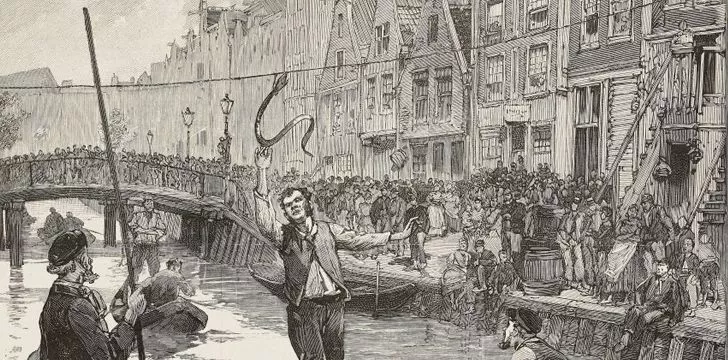There was once a traditional Dutch game known as Eel Grabbing, whereby a rope was strung up between two houses across a canal, and a live eel tied to the middle.
Men in small boats would float under the string and try to yank the eel from it.
The winner would often receive a hefty sum, with some winners’ pots being as much as 6 Guilders – a week’s wages.
How did this slippery sport start a riot?
On July 25, 1886, a large crowd of people had gathered to witness a game of now-outlawed Eel Grabbing on Lindengracht in Amsterdam.
Four officers from a nearby police station set out to put a stop to the spectacle, entering one of the houses from which the rope had been tied up and cutting it down.
Don’t anger the Dutch.
However, this didn’t go down well with the huge crowd of people who had turned up to watch some Eel Grabbing.
As soon as the police exited the house, one of the disgruntled spectators started beating the officers with his umbrella.
From umbrellas to batons.
A few hours later this had turned into a full-blown riot, with police using their batons to beat back the rampaging masses whilst the rioters hurled rocks and other projectiles at the police.
As nightfall came the temperature dropped and so did the tempers of the rioters, calming the incident down and seemingly bringing it to a close.
Another day, another Dutch dispute.
But as dawn came the rioters, now invigorated after a drizzly night’s rest, returned in force to storm the police station in protest to their illegal game of Eel Grabbing being stopped.
This led to the military being mobilized and getting out their guns.
As you can imagine, this led to a pretty big confrontation between the armed soldiers and unarmed rioters.
The tragedy of it all.
What happened next was the same thing that always happens in history when people without guns stand up to people with guns.
The army fired their muskets into the crowd, enveloping the whole scene in smoke, as smokeless gun powder had yet to be invented, and as the smoke cleared, 26 rioters lay dead on the streets, with the rest having fled back to their homes.
In the aftermath of these riots, two thousand protestors were arrested and the police offers were treated to cigars.
So that’s the story of Amsterdam’s infamous Eel Riots, which led to the deaths of 26 people.
Oh, and one eel – which later resurfaced at an auction in 1913 and sold for 175 Guilders, only to never be seen again.
Objectively speaking, one can’t help but think you could get the same effect with a dead eel and somebody jiggling the rope.


















